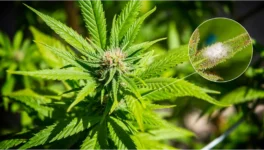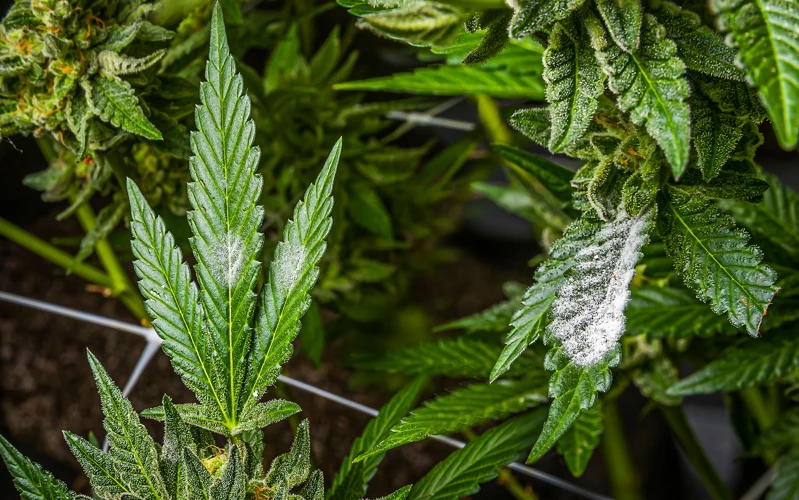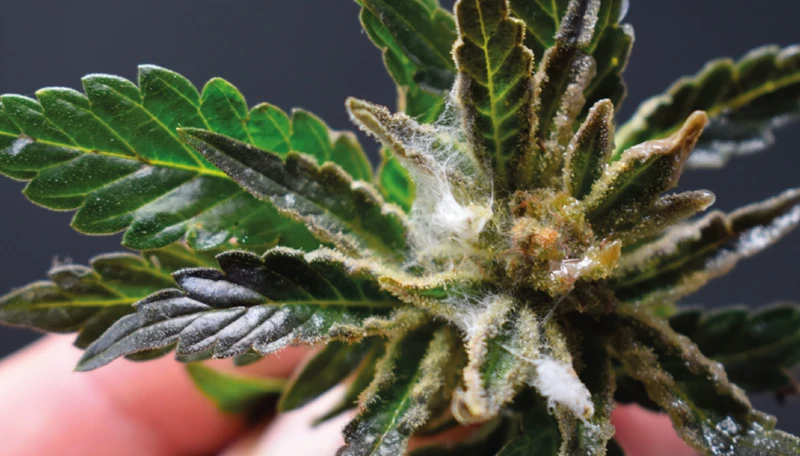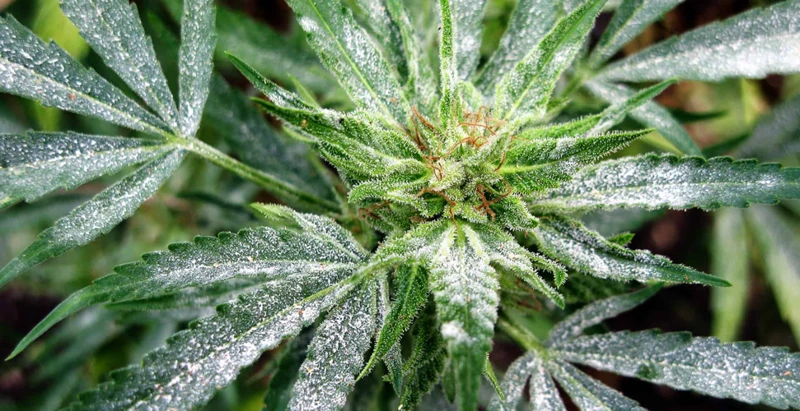
How to Prevent Mold and Mildew During the Flowering Stage of Cannabis
As a cannabis grower, the last thing you want is to see mold and mildew growing on your precious plants during the flowering stage. Not only can this adversely affect the quality and yield of your crop, but it can also pose health risks for consumers. It’s a perplexing problem that can leave growers scratching their heads in frustration. Fortunately, there are steps you can take to prevent and treat mold and mildew. In this article, we’ll explore the causes and effects of these fungi on cannabis plants, as well as practical measures to keep them at bay. We’ll also discuss treatment options and tips for properly harvesting, curing, and storing your crop to ensure the best possible outcome.
Understanding Mold and Mildew
Contents
As a cannabis grower, understanding potential threats to your crop is crucial for ensuring a successful harvest. Unfortunately, one of the most common threats to cannabis plants during the flowering stage is mold and mildew. These fungal infections can easily take hold if the necessary preventative measures are not taken. In this section, we’ll take an in-depth look at what mold and mildew are, how they can affect your cannabis plants, and why it’s so important to prevent their growth.
What are Mold and Mildew?
Mold and Mildew are types of fungi that can grow on cannabis plants during the flowering stage, which can be detrimental to their growth and overall health.
Mold: Mold is a type of fungus that thrives in damp environments and is characterized by fuzzy growth that can be a variety of colors such as white, gray, green, or black. This fuzzy growth can appear on various parts of the cannabis plant, including the buds, leaves, and stems. Mold can be harmful to the plant and can also cause health problems if consumed by humans.
Mildew: Mildew is also a type of fungus that grows in damp and humid environments, but it generally appears as a powdery white or gray substance on the leaves of the cannabis plant. Mildew can also affect the buds, causing them to become discolored and brittle. Like mold, mildew can also be harmful to the plant and can cause health problems if consumed.
Both mold and mildew are problematic for cannabis growers as they can significantly reduce the yield and quality of the plants. In extreme cases, they can destroy an entire crop, which can be devastating for growers who have invested significant time and money into their plants. It’s important to prevent the growth of mold and mildew in the first place and take appropriate measures if they do occur.
How Do They Affect Cannabis Plants?
Mold and mildew can have a devastating effect on cannabis plants during the flowering stage. When left unchecked, these fungi can spread quickly throughout the plants, leading to reduced yields and poorer quality buds. Here are some specific ways that mold and mildew can negatively impact cannabis plants:
- Reduced yields: Mold and mildew can cause flowers to become stunted and underdeveloped. This can lead to lower overall yields, as well as smaller and less dense buds that are less desirable for consumers.
- Potency loss: As mold and mildew grow on plants, they can eat away at cannabinoids and terpenes, leading to a loss of potency and flavor in the final product.
- Health risks: Some types of mold and mildew can produce toxins that are harmful to humans when consumed. This is a major concern in the cannabis industry, as many patients and consumers use cannabis for medicinal purposes.
- Plant death: In severe cases, mold and mildew can kill a cannabis plant outright. This can be a devastating loss for growers, especially if the plant was part of a larger crop.
Given these risks, it’s crucial for growers to take steps to prevent mold and mildew from taking hold during the flowering stage. Proper air circulation, temperature and humidity control, and sanitation practices are all key components of an effective prevention strategy. Additionally, regular plant inspections and quick treatment of any symptoms of mold or mildew can help to minimize the risks of an infestation.
Preventative Measures
One of the most effective ways to combat mold and mildew during the flowering stage of cannabis is to take preventative measures before they become a problem. By implementing proper protocols and practices, cultivators can greatly reduce the risk of mold and mildew affecting their plants. In this section, we will explore some of the key preventative measures that can be taken to keep mold and mildew at bay. From ensuring proper air circulation to maintaining a clean growing environment, every step counts towards a successful harvest.
Proper Air Circulation
A crucial aspect of preventing mold and mildew during the flowering stage of cannabis is ensuring proper air circulation within your grow space. Poor air circulation can lead to stagnant air, which can create a hospitable environment for mold and mildew to thrive. Here are some tips for improving air circulation:
- Use fans: Strategically placing fans throughout your grow space can help to promote air movement and prevent stagnant air. Oscillating fans are particularly effective at moving air around the entire space.
- Proper ventilation: Ensuring that your grow space has proper ventilation can also aid in air circulation. Proper ventilation includes installing an exhaust system, air intake vents, and carbon filters to maintain adequate airflow and remove stale air from the grow room.
- Keep the area clean: Dust, debris, and other pollutants can clog up air filters, which can restrict airflow and contribute to stagnant air. Regularly cleaning your grow space can help to keep air circulating smoothly.
- Avoid overcrowding: Overcrowding your plants can restrict air flow and create humid pockets of air that can contribute to mold and mildew growth. Make sure your plants have enough space to promote proper air circulation.
By implementing these measures, you can help to ensure that air flows smoothly throughout your grow space and reduce the risk of mold and mildew growth.
Optimizing Temperature and Humidity
Maintaining proper temperature and humidity levels in the growing environment is critical in preventing the growth of mold and mildew. Cannabis plants thrive in a temperature range of 18-27°C (65-80°F), and humidity levels between 40-60%. Outside of this range, the risk of mold and mildew growth increases.
To keep your temperature and humidity levels in check, you can invest in a thermometer and hygrometer. These devices will allow you to closely monitor the conditions in your grow room and make adjustments as necessary.
Here’s a breakdown of optimal temperature and humidity levels for each stage of cannabis growth:
Stage | Temperature Range | Humidity Range
— | — | —
Seedling | 20-25°C (68-77°F) | 70-80%
Vegetative | 18-27°C (65-80°F) | 40-70%
Flowering | 20-26°C (68-78°F) | 40-50%
It’s important to note that during the flowering stage, when the buds are developing, maintaining proper humidity levels becomes especially important. High humidity levels can cause the buds to become too moist and create the perfect conditions for mold and mildew growth.
To regulate humidity levels, you can use a dehumidifier to remove excess moisture from the air. If you live in a particularly humid area, you may need to use a dehumidifier throughout the entire growing process.
Keeping your temperature and humidity levels within the optimal range for each stage of cannabis growth is a key factor in preventing the growth of mold and mildew. By closely monitoring these conditions and making adjustments as necessary, you can create a healthy and mold-free growing environment for your cannabis plants.
Maintaining a Clean Growing Environment
Maintaining a clean growing environment is crucial in preventing mold and mildew during the flowering stage of cannabis. Here are some steps to keep the growth area clean:
- Clean equipment: Regularly clean all the equipment used in the growing area such as trimming scissors, fans, and filters. Trim away any dead leaves or branches, as they can attract mold and mildew. Disinfect the equipment using a solution made of equal parts of isopropyl alcohol and water.
- Clean floors and walls: Sweep the floors and walls regularly to remove any debris or dust. Use a damp mop to clean the floors and walls. This will help reduce the amount of airborne spores in the growing area.
- Avoid overwatering: Do not overwater the plants as it can create a damp environment that promotes mold and mildew. Only water the plants when the soil is dry to a depth of about 1-2 inches.
- Use a clean growing medium: It is important to use a clean growing medium such as coco coir, perlite or vermiculite. These materials must be properly stored in sealed containers at room temperature. Do not allow them to get wet, as it can trigger mold and mildew growth.
- Control pest infestations: Pests such as spider mites, thrips, and whiteflies can weaken the plant and create entry points for mold and mildew. Use organic pesticides, neem oil, or beneficial predatory insects to control infestations.
Keeping the growing area clean and well-maintained will help prevent the onset of mold and mildew. By following these simple steps, cannabis growers can ensure healthy and potent plants for their harvest.
Inspecting Plants Regularly
Regular plant inspections are crucial to preventing mold and mildew during the flowering stage of cannabis growth. Inspecting plants regularly allows you to catch any signs of mold or mildew early, increasing the chances of effectively treating, or even preventing, an outbreak.
During plant inspections, it’s essential to look out for any unusual growth, discoloration, or spots on the leaves or buds. A magnifying glass or microscope can be extremely helpful in identifying early signs of mold or mildew. Additionally, pay attention to the smell of your plants as mold and mildew produce a distinct musty odor.
To ensure you don’t miss anything during your inspections, create a checklist using an html table like this:
| Area to Inspect | What to Look For |
|---|---|
| Leaves | Discoloration, spots, web-like growth, or anything unusual. |
| Buds | Discoloration, spots, web-like growth, or anything unusual. Smell for a musty odor. |
| Soil/Roots | Look for any signs of rot or decay. Check for proper drainage. |
| Grow Room Environment | Check for proper air circulation, temperature, and humidity levels. Verify that any air filters are clean and functioning correctly. |
Inspecting your plants regularly and thoroughly can make all the difference in preventing mold and mildew. Catching any issues early on can save you a lot of time and money in the long run.
Treatment Options
As much as we may try to prevent it, sometimes mold and mildew still find their way into our cannabis plants during the flowering stage. When this happens, it’s important to take swift action to avoid damage and potential loss of the crop. Treatment options are available to help combat the spread of mold and mildew, but it’s crucial to choose the right method that will effectively eradicate the problem while not compromising the quality of the harvest. Let’s explore some of the possible remedies and treatments for mold and mildew in cannabis plants during the flowering stage.
Organic Remedies
When it comes to treating mold and mildew in cannabis plants, organic remedies can be a safe and effective option for growers who prefer to avoid chemical treatments. Organic treatments can also be more environmentally friendly and better for overall plant health. Here are some organic remedies that can be used to prevent and treat mold and mildew during the flowering stage of cannabis:
- Neem oil: Neem oil is a natural insecticide and fungicide that can help prevent and treat powdery mildew and other fungal diseases. It can be applied as a foliar spray or added to the soil. However, it’s important to note that neem oil can also harm beneficial insects like bees and ladybugs, so it should be used sparingly and with caution.
- Baking soda: Baking soda is another natural fungicide that can be used to prevent and treat powdery mildew. Mix one tablespoon of baking soda with one gallon of water and spray the solution on the affected plants. Repeat every seven to ten days as needed.
- Milk: Yes, milk! It may seem surprising, but milk has been shown to be an effective treatment for powdery mildew. Mix one part milk with two parts water and spray the solution on the affected plants. Repeat every two weeks as needed.
- Garlic and chili pepper spray: Garlic and chili pepper are natural anti-fungal agents that can be used to prevent and treat mold and mildew. Crush three cloves of garlic and one chili pepper and steep them in a quart of water overnight. Strain the mixture and add one tablespoon of dish soap. Spray the solution on the affected plants once or twice a week as needed.
While organic remedies can be effective, it’s important to note that prevention is always the best option. Make sure to maintain proper air circulation, temperature, and humidity levels, and keep the grow area clean to reduce the risk of mold and mildew. Regularly inspecting plants can also help identify and treat issues before they become more serious. If you do need to use a treatment, carefully follow instructions and monitor the plants closely to ensure they’re responding well to the remedy.
Chemical Treatments
Chemical treatments can be an effective way to eradicate mold and mildew from cannabis plants, but they should be used with caution. It’s important to follow product instructions carefully and to use protective equipment, such as gloves and a mask. Here are some commonly used chemical treatments for preventing mold and mildew during the flowering stage of cannabis:
- Fungicides: Fungicides are designed to kill or prevent the growth of fungi, including mold and mildew. They can be applied as a spray directly onto the plants, but it’s important to use a product specifically formulated for cannabis and to follow the instructions carefully to avoid damaging the plants. Some common fungicides used in cannabis cultivation include trifloxystrobin, pyrethrins, and copper-based fungicides.
- Bactericides: Bactericides are used to kill or prevent the growth of bacteria, which can also contribute to mold and mildew growth. They can be applied as a spray or added to the nutrient solution. However, it’s important to note that some bactericides can harm beneficial bacteria in the soil, so use with caution.
- Pesticides: Some pesticides can also be effective at preventing mold and mildew growth, but they should only be used if there is evidence of insect infestation. It’s important to choose a product that is safe for use on cannabis and to follow instructions carefully.
It’s important to note that chemical treatments should be a last resort, as they can have negative effects on the environment and on the plants themselves. Some chemical residues may remain on the plants even after harvest, which could be harmful for those who consume the cannabis. Organic remedies are generally preferable, but in some cases, chemical treatments may be necessary to protect your plants from mold and mildew. Make sure to weigh the risks and benefits before using any chemical treatments.
Harvest and Post-Harvest
After months of carefully tending to your cannabis plants, the moment has finally arrived to harvest and cure your crop. This phase of the growth cycle is crucial to ensure the highest quality and potency of your buds. Proper harvest techniques and post-harvest care can also prevent the growth of mold and mildew on your precious harvest. In this section, we will discuss the steps you can take to ensure a successful harvest and post-harvest phase, as well as tips for curing and storing your cannabis buds.
Proper Harvest Techniques
Harvesting cannabis plants is a crucial step in the process of cultivating high-quality buds. A proper harvest involves more than just cutting down the plants at the right time. Here are some essential techniques for ensuring a successful harvest:
| Technique | Description |
|---|---|
| Timing | Harvest at the right time by examining the trichomes (tiny, crystal-like structures on the buds). Look for mostly cloudy trichomes with some amber ones, which indicate peak ripeness. |
| Trimming | Remove any large leaves and trim off the smaller ones close to the buds. This will improve the quality of the buds and make them easier to handle. |
| Drying | Dry the buds in a cool, dark, and well-ventilated area. Hanging them upside down on a drying line or rack with a fan circulating air is a popular method. This can take up to ten days or more, depending on the humidity and temperature. |
| Curing | After the buds are dry, the curing process begins. Curing involves storing the buds in airtight glass jars, opening them for a few minutes each day to release excess moisture. This continues for two to four weeks or until the desired moisture content is achieved. |
| Storage | Once properly cured, the buds can be stored in airtight containers in a cool and dark location. Mason jars or other similar containers work well, as long as they are not exposed to heat or light, which can degrade the quality of the buds over time. |
Proper harvest techniques are essential to maintaining the quality of the buds and ensuring they are safe to consume. Rushing the process or cutting corners can result in a subpar product. Take the time to master these techniques to produce high-quality buds that can be enjoyed for months to come.
Curing and Storage
After harvesting your cannabis plants, it is crucial to properly cure and store the buds to prevent mold and mildew growth. This process involves drying the buds slowly in a controlled environment, then storing them in airtight containers, such as glass jars.
Drying: To begin the curing process, the buds should be hung upside down in a dark, well-ventilated room with a temperature of around 60-70°F and a humidity level of 45-55%. This allows for slow drying, which helps to preserve the potency and flavor of the buds. It is important to check on the buds regularly and remove any that show signs of mold or mildew.
Curing: Once the buds are dry, they should be placed in airtight glass jars, filling them to about 75% capacity. The jars should be stored in a cool, dark place with a temperature of around 60-70°F and a humidity level of 50-60%. Over the first few days, it is important to “burp” the jars by opening them for a few minutes each day to release any excess moisture. This helps to prevent mold and mildew growth.
Storage: Proper storage of cured buds is essential for maintaining their quality over time. Store the jars in a cool, dark place with a steady temperature and humidity level. Avoid exposing the buds to light or extreme temperatures, as this can degrade their potency and flavor.
Here is a table summarizing the key points of the curing and storage process:
| Step | Details |
|---|---|
| Drying | Hang buds upside down in a dark, well-ventilated room at 60-70°F and 45-55% humidity. Check regularly for mold or mildew. |
| Curing | Place dried buds in airtight glass jars, filling them to 75% capacity. Store in a cool, dark place at 60-70°F and 50-60% humidity. “Burp” jars for a few minutes each day over the first few days. |
| Storage | Store jars in a cool, dark place with a steady temperature and humidity level. Avoid exposing buds to light or extreme temperatures. |
Following these steps for proper curing and storage of your cannabis buds can help ensure they retain their potency, flavor, and overall quality over time.
Conclusion
In conclusion, preventing mold and mildew during the flowering stage of cannabis is crucial for producing high-quality buds. Neglecting preventative measures can lead to a multitude of issues, ranging from a compromised crop to unwanted health effects from consuming moldy cannabis. It is important to understand what mold and mildew are, how they affect cannabis, and what steps can be taken to prevent and treat them.
Proper air circulation, optimizing temperature and humidity, maintaining a clean growing environment, and inspecting plants regularly are all preventative measures that can greatly reduce the risk of mold and mildew growth. These steps are relatively simple and straightforward but require consistent vigilance and attention to detail to be effective.
If mold and mildew are discovered on plants, there are both organic remedies and chemical treatments available. Choosing the appropriate treatment option depends on the severity of the infestation and personal preferences.
After harvest, it is crucial to practice proper harvesting techniques and curing and storage procedures to avoid the growth of mold and mildew on stored buds.
Overall, preventing mold and mildew during the flowering stage of cannabis is necessary for producing high-quality buds, promoting plant health, and ensuring consumer safety. By understanding the risks and taking preventative measures, cannabis growers can protect their crops and can enjoy a bountiful and healthy harvest.
Frequently Asked Questions
What causes mold and mildew to grow on cannabis plants?
Mold and mildew thrive in warm and humid environments, and are often caused by poor air circulation and inadequate ventilation.
What are the signs of mold and mildew on cannabis plants?
Mold and mildew can appear as white or grayish powdery substances on leaves and buds, as well as an unpleasant musty smell.
What should I do if I find mold or mildew on my cannabis plants?
It’s important to act quickly to prevent the spread of mold and mildew. Cut off any infected areas and dispose of them, and consider treating the remaining plants with organic remedies or chemical treatments.
How can I prevent mold and mildew from growing on my cannabis plants?
Proper air circulation, optimized temperature and humidity, maintaining a clean growing environment, and inspecting plants regularly are all effective preventative measures.
What is the ideal temperature and humidity range for preventing mold and mildew on cannabis plants?
The ideal temperature range is generally between 68-77°F, and the ideal humidity range is between 40-60%.
What organic remedies can I use to treat mold and mildew on cannabis plants?
Some effective organic remedies include neem oil, hydrogen peroxide, and baking soda solutions.
What chemical treatments can I use to treat mold and mildew on cannabis plants?
Chemical treatments such as fungicides and pesticidal soaps can be effective, but should be used with caution to avoid damaging the plants and potentially harmful effects on human health.
What are the proper harvest techniques to prevent mold and mildew from developing during the curing process?
Harvesting when the plants are dry, trimming off any excess leaves, and allowing for proper air circulation during the curing process can all help prevent mold and mildew from developing.
How long should I cure my harvested cannabis plants to prevent mold and mildew?
Curing should ideally be done for at least 30 days, in a cool and dry environment with proper air circulation.
Can mold or mildew on cannabis plants be harmful to human health?
Yes, mold and mildew on cannabis plants can contain harmful toxins and lead to respiratory issues if ingested or inhaled. It’s important to take preventative measures to ensure a safe and healthy growing environment.





